#fossil pigeons
Explore tagged Tumblr posts
Text
Animal of the Day!
Dodo (Raphus cucullatus)

(Photo from Smithsonian Magazine)
Extinction Date- 1681
Habitat- Island of Mauritius
Size (Weight/Length)- 22 kg; 90 cm tall
Diet- Fruits; Nuts; Roots; Seeds
Cool Facts- As dodos went extinct in the 1600’s, we only know what they look like from incomplete skeletons and illustrations. These large birds were found only on the tiny Island of Mauritius off the coast of Madagascar. Little is known about their behavior but their skeletons imply they could run extremely fast despite being unable to fly. Their large beak may have been used in territorial displays due to the Island’s limited resources. They were primarily vegetarians but would occasionally eat a crab or shellfish. People first visited the Island of Mauritius in 1507 and the dodos were quickly hunted by people and invasive species alike due to their flightless and fearless behavior. Today, the near threatened Nicobar pigeon is their closest relative. Cracking down on the illegal pet trade and their illegal poaching has resulted in the Nicobar pigeon doing much better than their long since passed relative.
Rating- 13/10 (Dodos were originally thought to be a myth and extinction to be propaganda.)
#animal of the day#animals#birds#friday#october 6#dodo#dodo bird#biology#science#conservation#the more you know#extinct#skeleton#fossil#but not really#subfossil#extinctober#nicobar pigeon
203 notes
·
View notes
Text
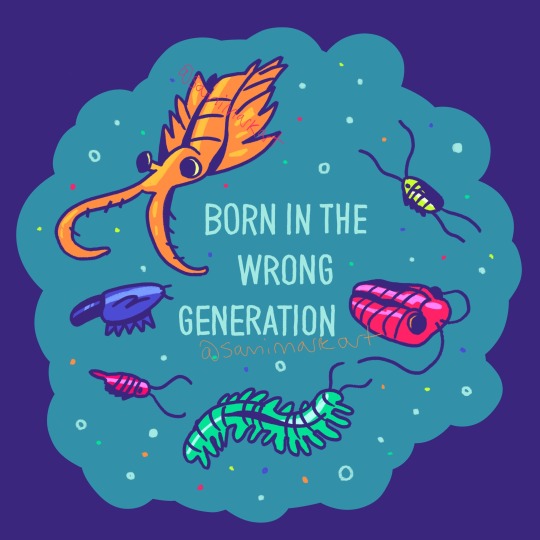
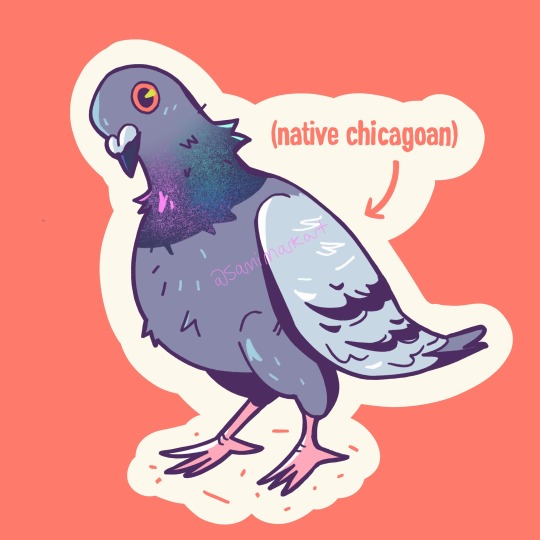
doodled more sticker designs last night to take my mind off the storm that was going on outside :)
63 notes
·
View notes
Text
The Birds I Never Met | North America's Extinct Birds
youtube
Recently I looked into a number of extinct birds from all around the world, but few of them shed light on those that I would've lived alongside. Today we're "borrowing" my mom's field guide on the Birds of Eastern and Central North America to learn about those birds that I might've witnessed had I been alive only a century ago!
#SIXTH EXTINCTION#birds#extinction#extinct#lost birds of North America#Ivory-Billed Woodpecker#Carolina Parakeet#Labrador Duck#Heath Hen#Passenger Pigeon#FOSSIL NOVEMBIRB#Youtube
82 notes
·
View notes
Note
hiiii vic how r you <- being tormented by mr kurtis conners dyke potential
hi im alright but now im very intrigued. tell me about kurtis conners dyke potential (<- has a very very vague image of his face akin to a mirage and thats it)
#first day of family trip has gone alright i saw a HUUUUUUGE and incredibly intact triceratops skull fossil that was just. out. on a table.#like no glass case or anything. but it was soooo cool#it was in a rock/fossil shop and the guy who owrked there apparebtly used to teach at my school and he told me that in one of the chem rooms#there's a bricked-off pirtion under a counter that has radioactive substances behind it. and they dont know how it got there. and just#sealed it off instead of removing it. which seems pretty par for the course for my school district honestly.#carrier pigeons!!#april
28 notes
·
View notes
Note
idk if I asked you yet but favorite prehistoric animal?
AHEM
so for dinosaurs tyrannosaurus rex was always the favorite dinosaur ever even when i was a child and still is . it just looks awesome i dont mean its cus it was a powerful predator (that too) but it just looks so cute. its face makes me think of a dog kind of but i just love them <3 then other favorite dinosaurs are pachyrhinosaurus, specifically lakustai cause of the horns on its frill (walking with dinosaurs 3D/the movie made me love them more *atleast the version with no talking*), carnotaurus cus their little horns are so unique but theyre also absolutely SOSIG, may i say baryonyx too. i dont know why it just is
other prehistoric animals i may wanna mention (counts as a dinosaur too anyways) are dodos..... i remember reading a shitton of articles about them..... it kinda breaks my heart they got hunted to extinction. anyways, most most favorite one is also mammoth (because i already love elephants theyre my favorite animals) because IF YOU ALREADY LOVE ELEPHANTS WHY WOULD YOU NOT LOVE. THE FLUFFY ONES. then honorable mention to dimetrodons because they look funky. and also fool you because they ''look like dinosaurs'' to most people but theyre not
i may be forgetting some if not alot but those are the ones i can name on the top of my head...
#ask#dodos also fascinate me because of that one mummy fossil#like. it looks so alive. it looks alive#yet its not#also theyre pigeon relatives isnt that awesome#same thing with mammoths with the mummy thing
11 notes
·
View notes
Text

Magic In The Future Ideas
Universities have departments of magic, offering degrees in subjects such as magical anthropology, magical energy studies, comparative magic and magical theology.
Research magicians apply for grants from the government.
MRI scans detect what results from magic activity has on the brain
Some psychotherapists specialize in treating magic-traumatized victims
A large part of each nation's military budget goes towards magical weapons and defenses.
In some areas, magic is so frequent that the concentration of magical energies leads to problems: pets display disturbed behavior, wildlife fail to reproduce, and homing pigeons lose their way.
Instead of finding witchcraft cool, teenagers moan about having to study magic in school.
Software and apps enable ordinary people to use magic on their computers.
In some countries, denying the existence of magic is a punishable offense.
In totalitarian states, all magic is controlled by the government. Anyone found practicing magic without permission gets imprisoned.
Unprotected exposure to large doses of magic is harmful.
Magicians seek publication in peer-reviewed journals.
Environmentalists advocate the use of magic instead of fossil fuel.
Large-scale studies compare the effectiveness of different spells and magic systems on different people, complete with control groups and placebos.
Hospitals employ healing magicians the same way they employ surgeons and scrub nurses.
Teams of mages compete in televised contests.
After decades of unrestricted magic use, humans become aware that magic harms the environment. By that time, Earth suffers the consequences of heavy magic pollution.
─── ・ 。゚☆: *.☽ .* . ───
💎If you like my blog, buy me a coffee☕ and find me on instagram!
💎Before you ask, check out my masterpost part 1 and part 2
💎For early access to my content, become a Writing Wizard
#writing#writers and poets#writers on tumblr#creative writing#writeblr#helping writers#poets and writers#let's write#creative writers#resources for writers#writing process#writing inspiration#writing community#writing ideas#writing advice#writer#on writing#writing prompt#writerscommunity#writers life#writers community#writers block#writer stuff#writing practice#writing a book#writer on tumblr#writer things#writer problems#writer community#fantasy
531 notes
·
View notes
Text
memento mori
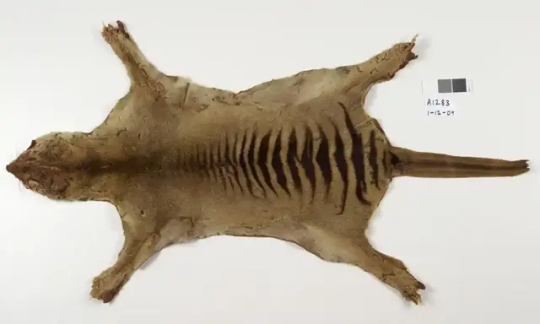
2. relics, but with extinct animals in place of saints

3. memorial portraits

4. pre-historical children's drawings

5. scientifically inaccurate bestiary art

6. close-ups from the Tapestry of Flowers and Animals

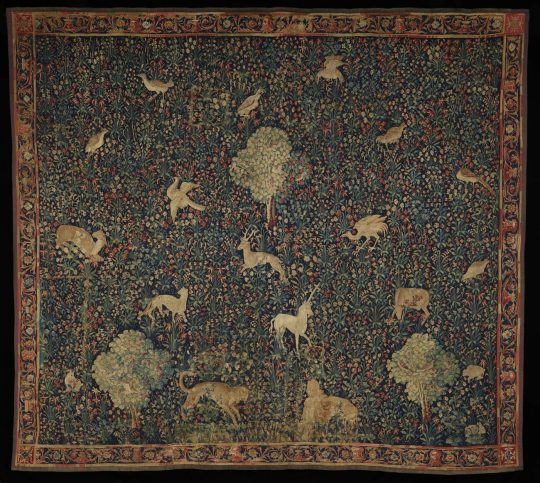
7. fossilized soft tissue

8. bad taxidermy
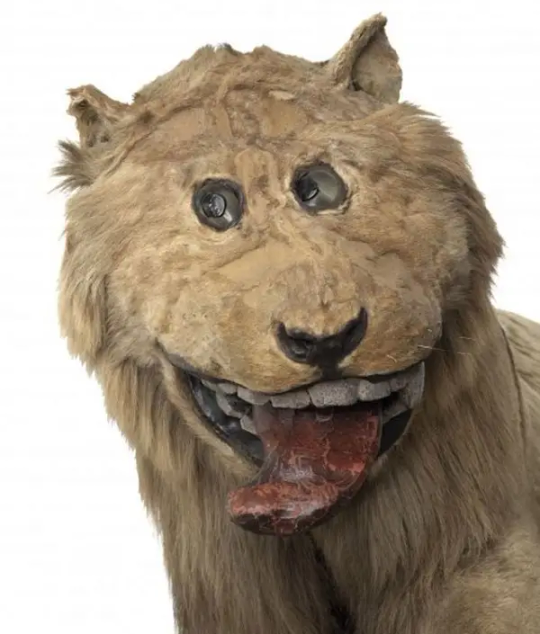
9. Ukiyo-e cats

10. cave drawings
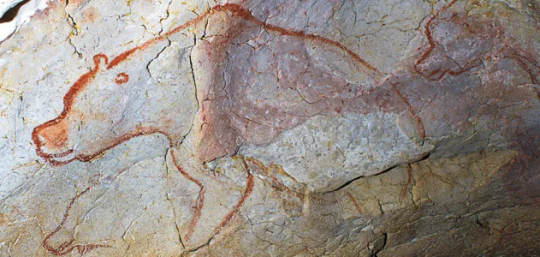
247 notes
·
View notes
Text
Pterodroma zinorum Rando et al., 2024 (new species)

(Skull of Pterodroma zinorum, from Rando et al., 2024)
Meaning of name: zinorum = for Paul Alexander Zino and Francis Zino [Portuguese ornithologists]
Suggested common name: Azorean little gadfly petrel
Age: Holocene (Meghalayan)
Where found: The Azores archipelago (at least on Graciosa, São Jorge, Pico, Terceira, and São Miguel)
How much is known: At least three partial skeletons including nearly complete skulls and multiple limb bones. Hundreds of isolated bones (mainly limb bones and some skull fragments) are also known, though it is unclear how many individuals are represented by these.
Notes: Pterodroma is the genus of gadfly petrels, a group of small- to medium-sized seabirds known for their fast, erratic flight. They are found across the world's oceans, but are most diverse in the Atlantic Basin. Their diet consists mainly of soft-bodied prey such as squid that they capture near the ocean's surface, and they only visit land to breed on islands.
Currently, three species of Pterodroma breed in two of the Macaronesian archipelagos in the North Atlantic, but a new study on their fossil record shows that the genus was once more widespread across Macaronesia in historical times and included at least one now-extinct species, the newly-named P. zinorum.
P. zinorum was slightly smaller than the average city pigeon and smaller than most other Atlantic Pterodroma species, being around the same size as Zino's petrel (P. madeira), which breeds on the island of Madeira in Macaronesia today. Compared to P. madeira, P. zinorum had slightly shorter wings and feet, as well as a taller and more curved tip of the beak. Radiocarbon dating of its bones indicate that P. zinorum survived to at least sometime within the 12th–17th Centuries. The exact cause of its extinction is unknown, but was likely human-driven given the recent timing and the fact that petrels are often vulnerable to disturbance of their nesting sites by humans and introduced predators.
Reference: Rando, J.C., H. Pieper, F. Pereira, E. Torres-Roig, and J.A. Alcover. 2024. Petrel extinction in Macaronesia (North-East Atlantic Ocean): the case of the genus Pterodroma (Aves: Procellariiformes: Procellariidae). Zoological Journal of the Linnean Society 202: zlae123. doi: 10.1093/zoolinnean/zlae123
#Palaeoblr#Birblr#Dinosaurs#Birds#Pterodroma zinorum#Azorean little gadfly petrel#Holocene#Europe#Phaethoquornithes#2024#Extinct
49 notes
·
View notes
Text
This is the first dinosaur we should clone.
(Birds are, of course, theropod dinosaurs, and while DNA deteriorates too much after tens of millions of years for us to be able to clone non-avian dinosaurs, there are actually a whole lot of magnificent extinct birds we could bring back. The Passenger pigeon and the Dodo are probably the most famous, but we could also reintroduce giant flightless plant-eating birds (Moas) and giant flightless predatory birds (Terror Birds), among others.)

On this day in 1914, Martha, the last-known living Passenger Pigeon (Ectopistes migratorius) died at the Cincinnati Zoo. Her death at age 29 after a lifetime in captivity marked the disappearance of her once-abundant species from the world. And it made her name synonymous with species extinction at human hands. But what happened?
Before the second half of the nineteenth century, the Passenger Pigeon was the most common bird in the United States, with a population numbering in the billions. Flocks of pigeons flying overhead were so dense that they could darken the skies. But a combination of overhunting and habitat destruction sent this species into decline, and by the turn of the century, it was considered extinct in the wild.
Photo: Enno Meyer, CC0 1.0, Wikimedia Commons
#Palaeontology#Fossils#Extinction#Passenger Pigeon#Dodo#Moa#Terror Birds#Environmentalism#Cloning#Jurassic Park#Dinosaurs#Birds Are Dinosaurs
683 notes
·
View notes
Text
=͟͟͞♡ 遠く離れても 歳をとっても
ひとつの誓い we’re never changing ᧔࿔᧓




에메랄드 ૮꒰ྀི ⸝⸝ᴗ͈ ‸ ᴗ͈⸝⸝ ꒱ྀིა :
♡ emerald / emmie ♡ minor ♡ she her ♡ infp
ㅤ ⏝ི ✧ ུ ⏝ 🪷
emerald의 좋아하는 것들 𖧁୧ tapioca (특히 말차나 타로) . nymphaea aelba also known as the lotus . cats . reading . fashion . makeup . tomorrow x together . slushynoobz . vanilla latte . anything cream cheese . pigeons (luzon bleeding heart) . making playlists and digging for music . poetry / literature . baking . sightseeing . staying in . ldshadowlady .
emerald의 음악 ꪆৎ tomorrow x together . beabadoobee . magdalena bay . tyler, the creator . le sserafim . say my name . katseye . ichiko aoba + more ! i love many girl groups
emerald’s top picks … ‘i killed you’ by tyler, the creator, ‘ひとつの誓い’ by tomorrow x together, ‘네버랜드를 떠나며’ by tomorrow x together, ‘ghost’ by magdalena bay, ‘beaches’ by beabadoobee, ‘미치지 못하는 이유’ by le sserafim, ‘don’t fade away’ by beach fossils, ‘this is how it went’ by beabadoobee, ‘together’ by beabadoobee, ‘dreamer’ by tomorrow x together, ‘kisses’ by slowdive, ‘fuck this world (interlude)’ by rina sawayama

do not interact if … trump supporter . basic criteria . anti shifter . israel apologist .
♡ things worth noting :
- i don’t care what others do in their desired reality unless it’s like literal manslaughter
- permashifter
- my resemble claim is always wested arin OR killuada
- if you shift for yeonjun i will likely not interact .. or block. i’m fine if u want him to be your significant other it’s just a bit 😬 for me
- if youre a nonshifter and you interact that’s okay !
- sometimes i use this blog to post things unrelated to shifting

tag definitions ꪆৎ
#verylongsillystring : every post
#verylongsillystring shitposts : not pretty shitposts
#verylongsillystring thoughts : me thinking about stuff
#verylongsillystring unrelated : not related to shifting
#verylongsillystring wants to show off : my brilliant curated ideas
#verylongsillystring boyfriend : my s/o in my drs (yeonjun)
#verylongsillystring says things? : things i can’t put into a category
#verylongsillystring 투바투 : txt reality
#verylongsillystring siis : soul ii soul (own gg) reality

♡ masterlist

#kpop shifting#reality shifting#shifting#shifting blog#verylongsillystring#law of assumption#txt shifting#shiftblr#loassumption#shifter
20 notes
·
View notes
Text
just when i thought i was gonna get outta this alive
I was disconsolately pecking at my attempts to do literally anything else with my life except be hyperfixated on this fic
and then i was like heh heh what if i filed the serial numbers off and put them in space
you know, like you do. but then i was like no, in space you lose the massive manpower requirements of all this; there's automated systems, there's computers, there's all this automated stuff. and i don't want to try to warp these character dynamics around to use that. i don't want them typing into screens or programming things. the aesthetics are all wrong. and i've written attempts at space things before and i don't like how cold space is and it's just. i mean i don't hate it, and there could be planetside stuff maybe, but i just.
idk i was chewing on it and gave up to go do something else and then was struck with great force as if from a great height with the memory that the Thing i Was Working On last time i tried to do really original fic was this whole solarpunk universe
I mean there were mammoths in it, which was what I was most excited about, but also post-industrial technology. no fossil fuels but all kinds of solar, wind, water power, and the main overarching plot thing I was working on was that there had been a solar flare that had taken down radio communications, and this was a periodic thing so civilization was used to working around periodic outages-- I did all this research into homing pigeons etc-- but part of what was hanging me up on the story was, I think, a problem that I'd made this huge setting and this potentially massive complicated societal whatsit and then I was having just two people work on the World-Altering Problem and it was too cozy.
so i actually did a side story with other characters set in that world to kind of further explore where that could go, and never really got anywhere with it but had Just So Goddamn Much Aesthetic stuff, really I did
anyway
what if several of the societies in this world have reinvented tall ships and have elaborate systems of merchant marines and navies
it's a post-industrial-collapse kind of setting with many reasons that large-scale industry hasn't returned, but they could manage tall ships, with some modern conveniences, but they'd still have at their core fairly old-school technologies. and it could be such a good plot to have them used to dealing with brief radio outages but then be hit by a massive one that isn't resolving. like, alongside my original plot.
anyway.
now i'm reimagining this but solarpunk, hold onto your hats.
i mean i'm gonna keep going on the OG for a little while too don't worry because I just got to a good part but
that's what I'm considering.
25 notes
·
View notes
Note
I had a two part American History class that covered 1877 and back, plus 1877 to present. In the 1877 and back we had a section about the first ever wildlife reserves/ national and state parks being established as people in the late 1800’s and early 1900’s started realizing that we were starting to have more man made and man transformed areas than true forest.
So the government started claiming certain areas to preserve them for people and one of the ways they got people to care about it was introducing recognized “park” animals they shipped over like the grey squirrel, classic red foxes, and pigeons; even though America already had native animals like red squirrels, fox squirrels, and various colorful birds that would become friendly in time. America’s red fox is actually hybrid of our native grey or reddish foxes and the European red fox.
“Grey squirrels were first introduced to England from North America in 1876 as an ornamental species to populate the grounds of stately homes. Around 30 separate introductions occurred until 1930 when the damage caused by the grey squirrel was recognized and it was made illegal to release a grey squirrel to the wild.”
I don't want to argue over this, but even your bolded section says they were introduced to England from North America, and Wikipedia says they're "native to the eastern and midwestern United States, and to the southerly portions of the central provinces of Canada," even mentioning their appearance in the fossil record.
However, they are listed as invasive in western North America and other locations and are a threat to native squirrel species in the areas where they've been introduced.

Intentional introduction of invasive species for aesthetics is so sad and frustrating. Please just appreciate the animals that were already there.
18 notes
·
View notes
Text
Evolutionary biologists at Johns Hopkins Medicine report they have combined PET scans of modern pigeons along with studies of dinosaur fossils to help answer an enduring question in biology: How did the brains of birds evolve to enable them to fly? The answer, they say, appears to be an adaptive increase in the size of the cerebellum in some fossil vertebrates. The cerebellum is a brain region responsible for movement and motor control. The research findings are published in the Jan. 31 issue of the Proceedings of the Royal Society B.
Continue Reading.
73 notes
·
View notes
Text
Fossil Novembirb 9: Getting a Grip
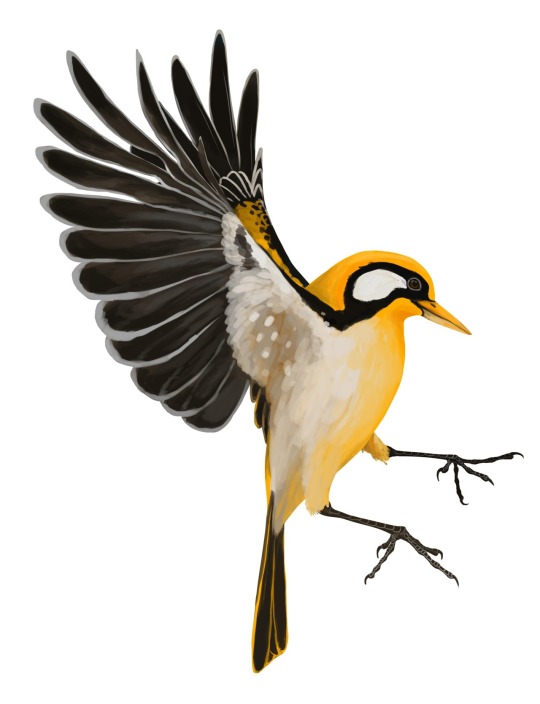
Zygodactylus by @thewoodparable
Today, half of all birds - so half of all living dinosaurs - are in a clade called Passeriformes, aka "Perching Birds". Of course, not all birds that perch are in this clade, but what can you do. With three toes forward and one long toe facing back, these animals can easily perch upright on branches and have tendons in their legs to help stiffen their grip while sleeping, enabling them to stay put!
But where did this giant group get started?
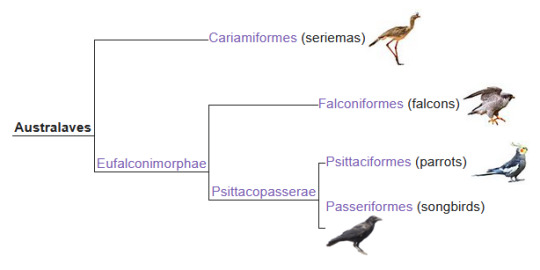
Australaves phylogenetic tree from Wikipedia
For a while, the prevalent idea was that they evolved from similar birds that perch in trees, such as pigeons and swifts. However, genetic evidence showed that the closest relatives of passerines were actually... parrots! And their closest relatives are Falcons, and just outside of that, Seriemas! What a wild twist!
Of course, paleontologists - being paleontologists - wanted to find the fossil evidence of this evolution. Luckily, as the genetic picture became clear, so did the fossil one - a handful of fossil birds that were mysteries before suddenly became clear, and more and more are being found as time goes on.
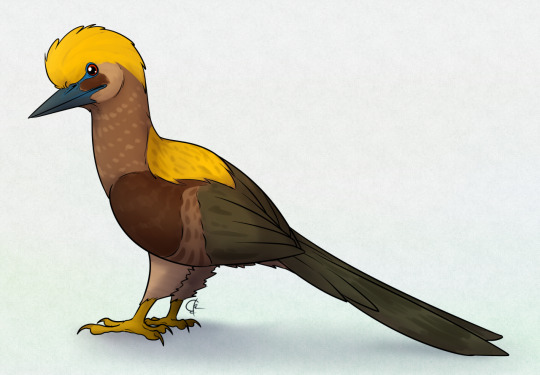
Primozygodactylus by @quetzalpali-art
In the Early Eocene, many of these early Passerine-Parrot relatives existed, and showcase a fascinating stepwise evolution of Passerine characteristics - namely, the feet. While the smaller head and size of Passerines evolved first, and show up in early relatives such as Zygodactylus, the foot arangement? Not so much. Instead, these animals had the bodies of passerines, and the feet of parrots! This indicates that the skinny legs and specialized wing shape of Passerines evolved first, and the special feet second. Truly, this and the many other stem-passerines we have found with this configuration qualify as "Evolutionary Missing Links". Dinosaurs remain our best way to show how evolution has happened over time! But I digress.
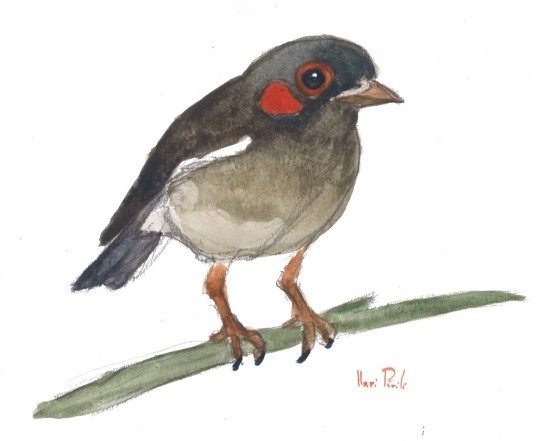
Eofringillirostrum by @otussketching
From these animals eventually came Passerines, though they were not especially common to begin with - many other birds lived in trees too, such as Mousebirds, and like all great dynasties, Passerines needed time to get started. That doesn't mean they weren't around - Eofringillirostrum, one of the smallest fossil dinosaurs we have, was already living kind of like a modern finch, without being closely related to them!
What's weird, however, is that most of our earliest known passerine and stem-passerine fossils are from North America and Europe. This is, however, a sampling bias - we just have spent more time looking for fossils in these locations. The "most basal" (ie, earliest-branching) passerines and parrots are both found in Aotearoa today - indicating that this clade probably diverged and first appeared somewhere in Oceania. Hopefully, fossils of these early Passerine-Parrots will be found in the region soon!
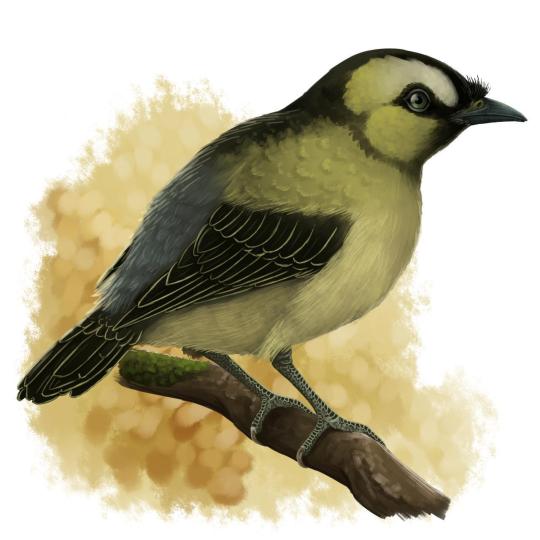
Wieslochia by @drawingwithdinosaurs
Alas, Passerine fossils of any kind do not become particularly common until the early Miocene, indicating that the climate change occurring globally at the time did allow Passerines to diversify more than they had previously. Perhaps Passerines were more adaptable to colder and drier climates than other tree birds had been, or their specialized perching feet allowed them to live easier in different types of forests. By the late Miocene, modern genera were even appearing. Though these delicately boned dinosaurs do not fossilize easily, more and more of the puzzle is showcasing how we got to the point where half of all living dinosaurs belong to this group.
In fact, thanks to genomics, we have something of an idea as to why Passerines speciate at the drop of a hat - and that reason is recombination! For some reason, Passeriformes are more prone to genomic restructuring and shuffling, with even short periods of separation between populations leading to rapid accumulation of these genomic architectural differences. Between that and the variety of ecologies such small arboreal animals can inhabit, it was just a perfect set of conditions for so many species to evolve - and honestly? I doubt Passeriformes are going anywhere any time soon.
Sources:
Conway, M., B. J. Olsen. 2019. Contrasting drivers of diversification rates on islands and continents across three passerine families. Proceedings of the Royal Society B 286(1915): 20191757.
Gibb, G. C., R. England, G. Hartig, P. A. McLenachan, B. L. Taylor Smith, B. J. McComish, A. Cooper, D. Penny. 2015. New Zealand Passerines Help Clarify the Diversification of Major Songbird Lineages during the Oligocene. Genome Biology and Evolution 7(11): 2983-2995.
Manthey, J. D., J. Klicka, G. M. Spellman. 2021. The Genomic Signature of Allopatric Speciation in a Songbird is Shaped by Genome Architecture (Aves: Certhia americana). Genome Biology and Evolution 13(8): evab120.
Mayr, G., A. C. Kitchener. 2022. Psittacopedids and zygodactylids: the diverse and species-rich Psittacopasserine birds from the early Eocen London Clay of Walton-on-the-Naze (Essex, UK). Historical Biology 35 (12): 2372-2395.
Mayr, 2022. Paleogene Fossil Birds, 2nd Edition. Springer Cham.
Mayr, 2017. Avian Evolution: The Fossil Record of Birds and its Paleobiological Significance (TOPA Topics in Paleobiology). Wiley Blackwell.
Mayr, G. and A. Manegold. 2006. New specimens of the earliest European passeriform bird. Acta Palaeontologica Polonica 51(2):315-323.
139 notes
·
View notes
Text
A collection of out of context quotes from Off-Book: The Improvised Musical Podcast because it is criminally underrated and more people need to know about it:
"Relax, you're at the lake-[WHEEZE]"
"My name's not Vanessa, it's Li'l Fossil!"
"Who do I gotta eat to be king of this town?"
"I'm an empath, but I'm not good at it."
"It's hard to be married to a guy that everyone respects."
"I'm going to smoke several packs of cigarettes!"
"Congratulations, you successfully stole that baby!"
"Everyone get your sweaters off."
"I was about to be inwardly sad, but outwardly brave."
"What do you mean "he's fine"? He's dead!"
"She's as stupid as that Sally Fields!"
"We're all gonna die soon."
"Buy a stupid little sack for your baby!"
"When you're looking at a microwave, that's not a microwave, it's basically dirt!"
"It's you!....say what you are!"
"When you were born, you came tumbling out."
"You can't just call upon a Ratatouille, like, a Ratatouille has to happen to you, you know?"
"Which war was it?"
"Tombathy, if I wanted a silver gear, I would have been born a poor person!"
"I don't know you anymore. I'm famous now."
"I gotta take a sip of liquid death-"
"But honestly, you know what might solve that?: patricide."
"How does a hot chocolate man have his own camera?"
"You can't stop the war that's about to begin!"
"My best friend is a 6 foot tall mouse!"
"I haven't heard you call me 'treasure' since 1992." "Yeah, that's probably when you started calling me John."
"Julia Roberts knows how to not upstage."
"Yeah, fuck you pigeon, I don't like you at all."
"Which came first? My dreams or these eggs?"
"No, it's because my father broke everything that started with K in the house one Christmas."
"No one's ever seen your face except for your wife? How did you grow up?" [....QUEUE SONG]
"I now pronunce this high school...dead."
"Stop that baby! She's headed to the stairs!"
"You wanna know the story with Santa and his marriage?"
#off book podcast#off book the improvised musical podcast#zach reino#jess mckenna#zach and jess#paul f. tompkins#nicole parker#carl tart#off book the improvised musical#drew tarver#alice stanley jr#kelly marie tran#matt rogers#phillip labes#madeline walter#queued
54 notes
·
View notes
Note
hi what are some of your favorite bird pokemon? do they have any Real Bird Details that you enjoy / fantasy bird-isms that you enjoy? holding notepad and pen
TEEHEEEEE I LOVE BIRD POKEMON.... my favourite of all time is my beloved pidove. literally a pigeon. with a heart on its chest. you must understand

i havent been into pokemon for a really long time but you can bet if you name a bird pokemon ill love it. some highlights:




because they are awesome.
lots of bird pokemon are, predictably, basically just birds. ^these guys up here are eagle (looks like a phillipine eagle), cormorant (they do swallow massive fish whole. like that it is eating pikachu. very swag), raven, and a barn swallow of course.
the lore im not super up to date on pokemon lore but it doesnt matter because there is a star among them all.... Archeops

YOU HAVE TO UNDERSTANDDDDDDD
archeops is based off of the first species/fossil of the bird lineage.... the first bird, Archaeopteryx.... its a transistional fossil that shows the evolution between theropods into birds, which you can actually see a lot of these traits on the pokemon as well (retains teeth, clawed forelimbs/wings, bony tail <- all traits of anscestral theropods that are lost in the evotion of birds + feathers and wings evolved for powered flight)
i also love that some of the dex entries say that they run better than they fly... its possible!! they arent though to be especially strong fliers, and it's likely that they glided more than they flapped, just cause they lack some of the anatomy that makes modern birds so effective (the keel for example. its a projection of the sternum/ breastbone that acts as a muscle attachment site for the pecs, so they can flap harder) they probably did do a fair bit of running. in any case it doesnt stock them from being flying types!
this is the famous fossil that you restore in pokemone BW (best pokemon games ever)

if i could bring Achaeopteryx back to life IRL i would i would recreate jurrassic park. i need to meet her. if pokemon was real i would resurrect her fossil 10800909390 times and cause an ecological disaster on purpose
8 notes
·
View notes